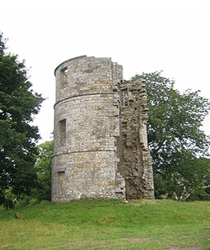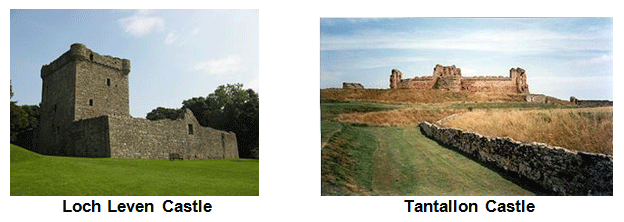Douglas

-
Clan Territory
Douglas territories can be found as far north as the Black Isle and across the Borders into Northumberland, but the main territories are in the Lowlands of Scotland. -
Clan Chief
Archibald Douglas, the first Duke of Douglas, was the last chief of the Clan Douglas. He died on June 21, 1761 and the title passed to James, the 7th Duke of Hamilton. The Dukes of Hamilton, whose family name is Douglas-Hamilton, are heir to the chiefdom of Clan Douglas, but cannot assume the title because the Lord Lyon King of Arms requires the duke to assume the single name Douglas.
Clan Douglas, also known as the House of Douglas, was one of the most powerful families in Scotland. Rivals of royalty, their origins are unknown. It was said of the Douglases, “Men have seen the stream, but who has seen the source?”
The name supposedly comes from the Gaelic dubh glas meaning black water or stream. In 1147 Theobaldus Flammatius - Theobald the Flemming – was given lands near Douglas Water in Lanarkshire in return for services to the Abbot of Kelso. The name Douglas first appears when William Douglas witnesses a charter of Bishop Jocelyn of Glasgow in 1174 and five years later he is recorded as Lord of Douglas. It is assumed he was Theobald the Flemming's son and the first to take the surname Douglas.
-
Clan Castles

Douglas Castle
Douglas Castle is the historic seat of Clan Douglas. Built sometime before 1288 it served as a stronghold to the nineteenth century. The castle was destroyed and replaced several times until the 18th century when a large mansion house was built in its place. The mansion was demolished in the 1938, and today only a single corner tower of the 17th-century castle remains.
The town of Castle Douglas in Dumfries and Galloway takes its name from Threave Castle which stands on an island in the River Dee, a mile and a half from the town. It was the home of the Black Douglas Earls of Douglas from the late 14th to the middle of the 15th century.

Threave Castle
Ruined castles, stately homes and palaces associated with the House of Douglas are scattered across Central and Southern Scotland. The ruins of Berwick Castle now form part of Berwick Railways Station while Drumlanrig Castle in Dumfries and Galloway is the 17th century mansion home of the Dukes of Buccleuch.

Hermitage Castle is now an eerie ruin, set in splendid isolation near Newcastleton in Scotland’s wild Border country. Dour and lonely, Hermitage has a history filled with murders, torture, treason and trysts, including a significant meeting between Mary Queen of Scots and Bothwell.
Dramatically set by a bend in the River Clyde, Bothwell is Scotland’s largest and finest 13th century castle. Part of the original circular keep survives and the huge central donjon is the best example in Scotland. The 14th-century great hall and chapel are from the times of the Black Douglases.
Loch Leven Castle is a ruin on an island in Loch Leven, near Kinross. In the late 14th century the castle was given to William, 1st Earl of Douglas and remained in Douglas hands for more than 300 years. This was where Mary Queen of Scots spent the most traumatic year of her life. In 1567 she was imprisoned and forced to abdicate before escaping the following year.Tantallon was the last truly great castle built in Scotland. Set on cliffs above the Firth of Forth, Tantallon was the seat of the Douglas Earls of Angus, one of the most powerful baronial families in Scotland. In the 1380s the dynastic house of Douglas split into two branches, known as the ‘Black’ and the ‘Red’. Tantallon passed to the junior line, the ‘Red Douglases’, Earls of Angus. The castle suffered three great sieges. The last, by Oliver Cromwell’s army, was so destructive that the castle was left to the birds.

-
Clan Tartans

-
Clan History
Sir James Douglas was also known as Good Sir James and the Black Douglas. His father fought with William Wallace and died in the Tower of London. Douglas fought with Bruce from shortly after Bruce killed the Red Comyn in Dumfries in 1306, and, according to John Barbour’s poem, The Bruce, was knighted after the victory at Bannockburn in 1314.
When Robert Bruce was dying in 1329 he asked Sir James to carry his heart to the Holy Land and present it at the Holy Sepulchre in Jerusalem as an act of penance for the Comyn murder, though, according to Barbour, the heart should be carried in battle as a token of his unfulfilled ambition to go on crusade. Bruce’s heart was cut from his body and placed in a silver and enameled casket which Sir James carried round his neck. In 1330, he left from Berwick upon Tweed with seven other knights, twenty six esquires and gentlemen.
Douglas broke his journey to help the Spaniards fight the Moorish kings of Granada and during the fight, popular legend has Douglas throw the casket with Bruce’s heart into the hoard of heathens, saying, “Lead on, Brave Heart. Douglas will follow thee or die!” But this anecdote appears to come from a 16th century addition to Barbour's poem which has Douglas make the gesture at the beginning of the battle. Douglas, and almost all of the men who fought with him, were killed. His body and the casket were found together. Douglas’s flesh was boiled from his bones and his skeleton and the heart were brought back to Scotland. Sir James’s bones are in the family vault at St Bride’s chapel, Douglas.

Bruce’s heart was buried at Melrose Abbey. The Good Sir James’s story and the Douglas rise to prominence, the murder of the Douglas chiefs at Edinburgh and Stirling Castles, their roles in the Civil War and the Jacobite rebellions are compellingly told in the Galloglas DVD, Clan Douglas. Filmed on location to the highest standards Clan Douglas features unique stories that interweave romance, murder and betrayal, set against stunning landscapes and is a must for every Douglas to own. This DVD is not yet available; if you would like to be informed of the release date please email alexandria@greatscottishclans.com.
-
And finally
Bruce's body was buried in Dunfermline Abbey. When the body was exhumed in 1818 it was wrapped in a cloth of gold and Bruce’s ribs were sawn through, indicating that the heart had been removed. In 1921, archaeologists discovered a lead casket beneath the Melrose Abbey Chapter House. The casket contained Bruce’s embalmed heart. It was reburied at Melrose Abbey on June 22, 1998, and two days later, on the anniversary of Bruce's victory at Bannockburn in 1314, the Secretary of State for Scotland unveiled a plaque above the heart.